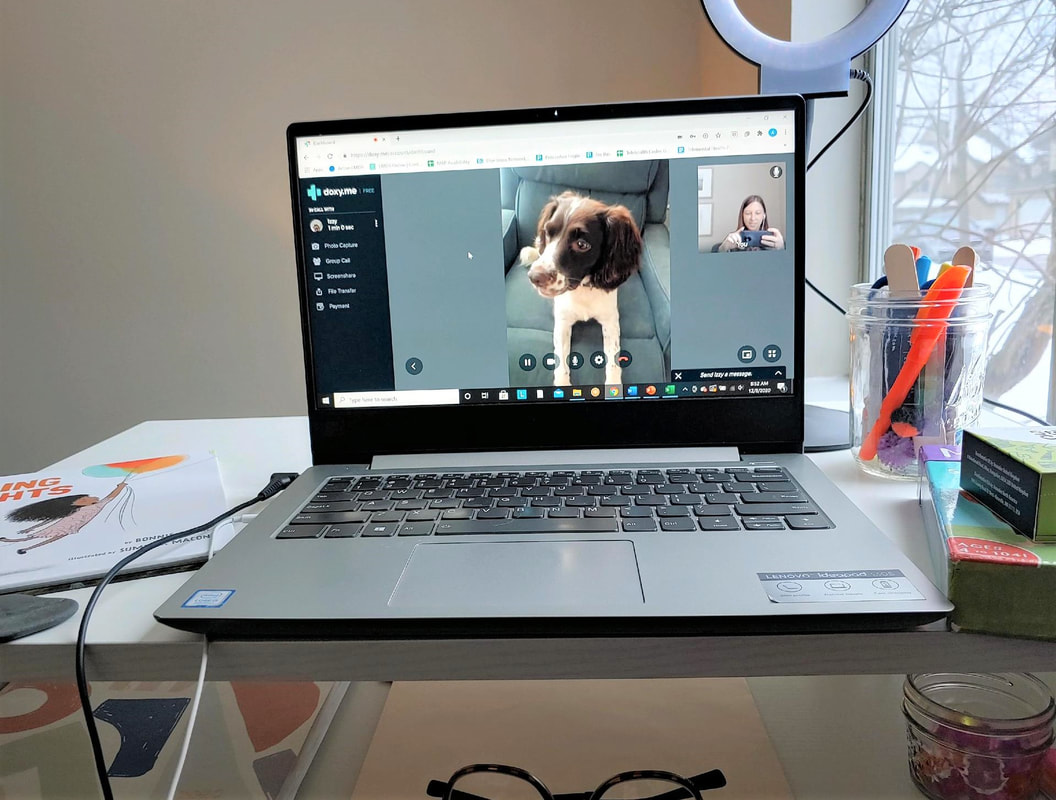|
First things first, I'm a little biased but.. isn't this client the CUTEST? Izzy is really getting her time to shine bright like a diamond here as an official therapy dog for this photo shoot. When this cute little pup became ours I had high hopes and dreams of her being a therapy dog I could take to the office. I did the trainings, took some CE courses, and it turns out.... field bread springer spaniels (at list this one) are not great therapy dog candidates. This was a GREAT lesson in radical acceptance of our Izzy just the way she is with all her unique gifts and talents.
Now that the introduction is out of the way, on to the tips! My Tele-Play journey has exploded since last March, but it didn’t begin there. As I mentioned HERE I began my Telemental Health practice a little under a year before that point as a way to support clients in my transition from the Twin Cities to Duluth, MN. For some it was a bridging between providers and for others it has been a consistent way that we engaged in therapy. Well…the 3-4 weeks I thought I would be practicing all virtual in March has (as I am sitting here typing this) turned into nine months. Nine whole months of Telehealth and Tele-Play. This journey has felt a little like a Dr. Suess book where I played in my garage (with a woodsy backdrop of course), the corner of my bedroom, and now a new home office as I transition living spaces! The office that was in the making two years ago and I never dreamed how much I would need it until now! Since I have been at this for a bit I wanted to share some of my reflections and a little more of the informal tips as I have navigated this space fully for the last 9 months, and anticipate that it won’t change anytime soon. If you and I were to sit down for coffee to chat (let’s be honest it would probably be virtual coffee right now) here is what I would tell you: Have a great informed consent Make sure that you are clear with parents and young people about what to expect and what their roles are. Some topics to be sure to cover is the specific platform, how they can login, where they can login from (ie only in your state depending on licensure and reciprocity rules for your license) backup platforms, way to contact you if they need to troubleshoot technology, who will be present during the session (the parent, the child, or a combination), what space sessions should take place in, how to maintain privacy, a plan for if technology goes down, ending rituals (mine is a “wave off” with parents so we can both be on the same page with exactly when the session is ending), and what materials the family may need to gather. For me I either have worked with the family to develop a play therapy kit at home or have sent kits HERE. We have gone over clear and specific rules about when and how toys will be played with and stored. Want to know more about informed consent? Check out this resource HERE! Have a great safety plan Have crystal clear information about what your role is should there be a crisis. Specifically, how you will react and what your plan is to keep them safe? For me I will call a parent if technology is down for two minutes and parents are required to be accessible by phone for the duration of the session. If the client has suicidal ideations have a clear plan that is communicated to the client about what steps you will take to keep them safe. If a client is not suicidal – you still need a safety plan! Think of things like if a child was choking or having a seizure, or if the parent was having a heart attack, etc. In the office you have control over how to get resources for help. Virtual requires an extra step. Verify location each time So, speaking of safety plans, if you don’t have their address in the moment any safety plan you have is useless! Oh, and sometimes (especially being in a boarder town) people visit relatives or go to the cabin in another state and even though you have clarified in your informed consent they need to be in the same state (if that applies to you) sometimes they forget and you don’t find out until they login. For a lot of clients, you may see the same picture in the background and you can easily verify they are at home with a quick “you’re at home today?”. I also HIGHLY recommend having quick and easy access to their address. Have backup plans Tech trouble happens. Ugh. More than we would like. I have had spontaneous updates on my computer, it shut down for some unknown reason, and the inevitable inability to login. Lately – on DoxyMe for a couple people my voice sounds like a robot for the first one to two minutes of the session and then we are business as usual. So, when we are talking backup, I mean both another devise to login on as well as virtual platforms. I have a phone (although not ideal) that I can login to platforms should my computer be out of commission and I have two online platforms that I can move seamlessly between should one not be working for a specific client. Be ready to improvise Client logs in at Uncle Ben’s for their appointment? Maybe it is within the state at a secure and private location but…they forgot their Play Therapy kit at home. For young people who I do mostly Child Centered work with, I always have some directive Play Therapy techniques on hand I can quickly go to that will help with work towards goals. Get clear on your boundaries Also really be clear on and limits, rules, and structure you want to create around things like clients logging in in the car, having others present during session, client’s not having their face on camera, and the list could go on! When you are clear then your clients also know what is permitted vs not – setting you both up for success! Get good ear gear For some of us we like the large ear covers where we look a little like a fighter pilot. For me, I prefer ear buds. Okay, here is where it gets a little TMI. Sometimes my ears get a little itchy. I guess that is what wearing these sometimes for 9 hours per day does. I like to immediately take out my buds between sessions and have found that these covers HERE allow my buds to stick in a bit better. Also – never underestimate the power of sanitizing your ear gear! I am very pro headphones because it minimizes any feedback that can happen. Although it is best case that both you and the client are wearing earbuds, most of my children don’t wear them as it restricts movement. However, I also take those babies out the moment we click off to give my ears a chance to rest. Oh, and I would recommend a backup set unless your headphones stay at your desk! I once lost my earbuds for two weeks and it was a bit stressful tearing apart my house to find them and waiting for Amazon to deliver me a new set! Get good internet There is nothing worse than video being dropped and glitching. Whatever you need to do to get the best internet signal you can is completely worth it for the quality of therapy you can provide to your clients. A good router, ability to plug right into the wall, and boosters will be your best friends. Lighting is key As someone who has moved around offices a bit, finding the right lighting is always the first step in a new space. When I most recently moved home office spaces I (of course) chose the space where the sun beamed in my face for the first 3 sessions of the day. Day two involved a desk move and MUCH nicer and softer lighting. You want lighting that is not too harsh, not too dark, but just right. Kind of like goldilocks. All of this is not so you look photoshoot ready, it is so the client has the best ability and chance to read all of the nonverbal cues you are giving them. I did order a ring light HERE for extra lighting. This one had pretty good reviews and a low price point, and for the times I have needed it, it has provided great light! It has a warm and cool light setting. AND I found out (after purchase) that it has panda ears, so that’s a win. Organize, organize, organize My Tele-Play life got SO much easier when I got really serious about getting a new desk and had plenty of space to spread out the things I needed. Our nervous systems work extra hard trying to decode dangerous from safe when we sift through clutter you are actually more relaxed when you go into a neat and organized space. I am not only talking about paperwork but toys too! I found that life got so much easier when I paired down my available Tele-Play toys to having one of the kits I sent to clients for Tele-Play and a select few Cognitive Behavioral Play Therapy toys like my big feeling eaters, Uno, and Mindful Kid Cards. Stay present This sometimes can be a hard one! In full transparency because I write my notes between sessions, there are always emails to check, and things to do, sometimes it can be hours before I stand up and move. Tuning into our bodies and understanding what we need is key. Sometimes it is intentional movement and stretching and other times it is a drink of water or some mindful breathing. During session my favorite go to strategies are a weighted lap blanket and a grounding object. I have several stones I have picked up on hikes and at the beach and sometimes just holding the physical object can help ground you to stay present with your client. Be curious about play themes I have found that Tele-Play offers so many rich play themes that one might initially interpret as “resistance”. Like, going out to sight of the camera or covering the camera up? Could this be a play theme of power, a new age “hide and seek” or playing out the difficulty with the distance? Coming close to the camera and then going far away could also be relational and distance themes. What about the kids to scare the living daylights out of you by putting something really scary up to the screen? I have SO enjoyed seeing how play themes shift in the virtual space. Have a good referral source This last one is a bit painful. Really painful. What we know is that research has found virtual sessions as effective and in some cases more effective than in office therapy. And, the hard truth is that some clients have such an intense difficulty with virtual and will need in person. I trust that each therapist carefully weights the pros and cons and makes decisions that are best for their practice and clients. For me it was all virtual. If a client is struggling it is SO helpful to have an in-person referral resource on hand to refer to should you need. As I am reflecting on these last nine months, Tele-Play is such a mixed bag. I talk about my gratitude for Tele-Play HERE. There is so much to be grateful for and Tele-Play has pushed me to be more creative and thoughtful about my practice. And, some days I feel sad, missing the in person nervous system connection, and missing the comfort of the Playroom. Some days it is the frustration of misattunement with a client when you can’t really tell if they are crying so you have to ask. OR when they are a wee bit back from the microphone and everything comes out garbled so you have to ask them to repeat themselves. And who can forget the ever popular “I can see you can you hear me” ritual that happens during logins. I know we will ride this wave and someday my Playroom will open. But until then I will keep on (virtually) playing on! So…if we were actually having a coffee chat, what would you share with me? Spill your BEST Tele-Play tips and reflections in the comments!
0 Comments
Leave a Reply. |
Hi, there!I'm Ann Meehan, an LPCC, Loading... Archives
July 2024
Categories
All
|
Privacy Policies | Terms of Use | Disclaimer
Contact
[email protected] | Copyright Meehan Mental Health Services 2022
Contact
[email protected] | Copyright Meehan Mental Health Services 2022





